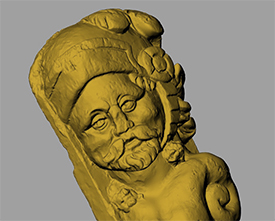
On Site
15 June 2010
By Kevin Stratford
The Swash Channel Wreck site has been actively studied since its discovery in 2006 and has formed the basis of many archaeological investigations during that period. These investigations provided the evidence to show that this rescue excavation was necessary on the areas of the wreck most at risk.
The project plan, having been agreed by English Heritage, was put into action on the 1st June 2010. The first day of the project consisted of a briefing on the work to be undertaken and the methodology of the project objectives.
The second day saw the first day of diving and we were blessed with near perfect weather conditions allowing the deployment of the scaffolding poles and construction of the four six by six metre grids. These grids were to be used as the guides for the excavation and subsequent photographic mosaic which forms the initial phase of the project.

Kevin Stratford coming up from a dive (photograph courtesy of Bournemouth University).
The excavation of the wreck was to be done using a double water dredge to allow two buddy diving teams to work at the same time and maximise the working hours that could be completed during a slack water time period. The excavation teams were split to work on separate grids to keep the consistency of recording and these same buddy pairs were used to complete the photo mosaic of the freshly excavated grid before the scaffolding frames were then moved on to the next position along the baseline. This method was decided upon in order to be able to establish a position for all stratified finds to a known position within the wreck.
As a part of the previous investigations on the site, three different trials of in-situ preservation were deployed. These consisted of one area of netting, an area of Terram (a geotextile that provides a physical barrier to erosion), and a section of artificial kelp forest. They were all designed as different techniques which could promote sediment cover on the covered area and as such reduce destruction by natural processes. Each trial was used at a different part of the upper works on the south eastern section of the wreck site. These trials all needed to be removed from the wreck site to allow the excavation and recording of this section of the wreck when the grids reached them. The section of netting had failed as very little sediment cover was noted during its removal which went straight onto degraded timber structure. The Terram and fake kelp forest both appear to have been effective in promoting sediment cover as a lot of anaerobic sand was seen as they were removed, hopefully allowing better preservation of the timber below.
At this early stage of the project it was clear that there was likely to be a large amount of buried material that was so far not seen. This was especially true to the starboard side of the wreck at the bow end where timbers were being uncovered off of the main wreck structure. These timbers included some which have not been seen elsewhere in the wreck and some shipbuilders' marks still survive on the surface.

A section of the merman found on the wreck in 2008. (photograph courtesy of Bournemouth University).
Along with these ships' timbers other finds included sections of rope, concretions, a clay pipe section (complete with a stamp on the underside of the head) and several rigging elements complete with rope.
The rudder is of major interest within the wreck site due to its carving that was recorded prior to conserving it in terram and sandbags. This also had to be uncovered in order to allow the excavation and photo mosaic as well as establishing the condition prior to the lifting process. During the process of uncovering the rudder a section of sheathing was recovered as it had fallen off of the rudder. Upon later inspection two layers of tarred hair were recorded, along with sacrificial timber planks.
The first 10 days of the project have been extremely successful, and have already provided many new insights into the nature of the wreck site along with possible new dating evidence. The rudder is of major interest within the wreck site involved with the project, both professional and volunteers, have quickly formed a good understanding of the site and its specific working problems. This understanding has enabled an exciting and vibrant international team forum for the discussion of excavation techniques along with construction ideas.
The next 20 days present great opportunities to take the hard work completed forward, and to develop the current understandings of the wreck site further to hopefully answer some of the remaining questions. The most notable of these are the identity and origin of the wreck.
Return to MUA Project Journals home page.

